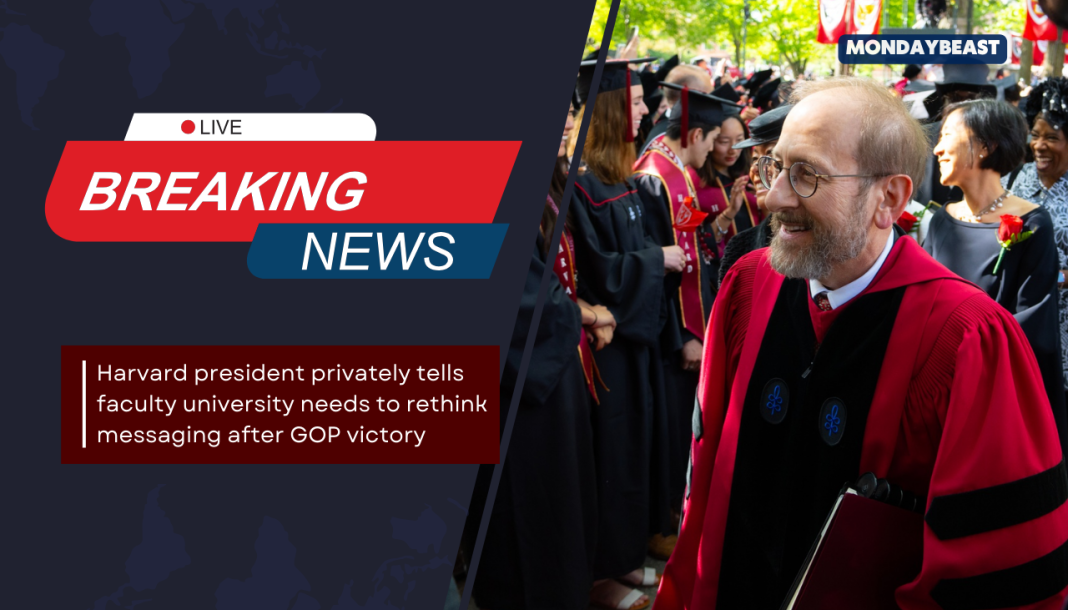In a time when the political landscape seems ever-changing, Harvard University is at a crossroads. After the Republican Party’s recent victory, President Alan M. Garber expressed pressing concerns to faculty. He emphasized the need for a critical reassessment of how their institution communicates with the wider public.
During a closed-door meeting, held on December 3, Garber reflected on the ‘anti-elite repudiation by the American electorate.’ His words resonated with the pulse of a nation seemingly fatigued with the status quo. It’s no surprise that many within academic circles felt bruised by the backlash.

Garber did not pull any punches. He described the current climate in Washington, D.C., which presents significant challenges for universities, particularly Harvard. His tone carried a weight of humility. He recognized that criticisms leveled against Harvard were not entirely unfounded.
According to anonymous faculty members who were present, Garber noted his extensive meetings with around 40 members of Congress. He acknowledged bipartisan frustrations. For many, those words struck home, likening them to a long overdue conversation that needed to happen.
Yet, while there was candor in Garber’s remarks, specifics on new strategies were scarce. A curious silence hung in the air. What exactly does a rethinking of messaging entail?

One cannot help but wonder how Harvard might recalibrate its approach. Could this lead to a stronger connection with those outside its hallowed halls? The stakes feel ever higher, especially with potential legislative threats looming.
Paul Andrew, Harvard’s Vice President for Public Affairs, laid bare the key concerns during that same meeting. Issues like the endowment tax and threats to federal funding emerged as pivotal points of worry. Many stakeholders perceive these legislative moves as direct attacks on academic freedom and institutional stability.
Looking outward, we can see how these challenges are not unique to Harvard. Institutions across the country are feeling the pressure. The recent criticism regarding free speech is particularly poignant. Indeed, Harvard scored the lowest ranking for free speech among 251 schools.

As the nation grapples with issues of censorship and academic integrity, Garber’s presidency arrives at a pivotal moment. The footsteps of dissent echo throughout campuses, questioning whether the guardians of knowledge have lost their way. How does a school like Harvard regain trust?
To add another layer, the expected arrival of Trump’s administration could signal even tougher scrutiny. Dr. Jay Bhattacharya, nominated for a significant role, seems poised to link research grants to institutional practices. Will it force universities to prioritize academic freedom over compliance?
Moreover, as we await forthcoming policies, Garber’s call for empathy and humility seems timely. But can Harvard genuinely shift its image so deeply intertwined with elitism? Or will this be yet another chapter in an ongoing saga of discontent?
For many, the role of higher education is evolving. The balance between tradition and innovation must be navigated with care. Universities must stand firm yet flexible in the face of external pressures.
Ultimately, the conversation around education, politics, and societal expectations is far from over. As an academic outsider, it leaves me with questions about the role of academic institutions in addressing contemporary issues. Can Harvard break free from the historical chains that bind it, and emerge as a trusted bastion of progressive thought?
With Garber at the helm, the journey forward might be filled with uncertainty. But one thing is clear: Harvard’s leadership is awakening to the call for transformation. It’s a pivotal moment that could redefine not just the university, but the broader landscape of higher education.




